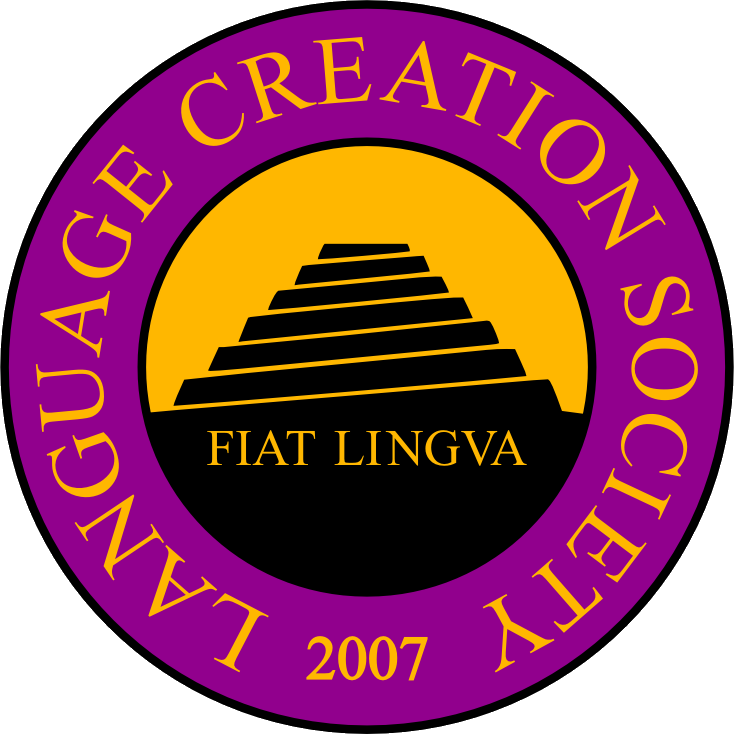LCC4 Speakers
 Carsten Becker carbeck@nullgmail.com |
Comparison in AyeriMany Indo-European languages use satellite particles of one kind or another or affixation for comparative constructions (e.g. “My house is bigger than a mountain”). Ayeri does things differently. In this talk, Carsten will discuss various comparative strategies found in natural languages, and then go into detail about how comparison works in Ayeri. |
| Carsten Becker got into conlanging basically through Lord of the Rings and looking for information on the languages there, since he was kind of fascinated with this detail. Anyways, he’s always preferred language classes to science ones. In 2003 he joined the ZBB as “Guitarplayer” after stumbling on Mark Rosenfelder’s Language Construction Kitand trying to make his first own language – the “Nameless Language” which has long been discarded now as it did not really please him and was basically a clone of the languages he knew and learned in school. Ayeri was started in December 2003 as his third attempt, and since then he’s worked on it in fits, mostly during holidays. He’s yet to present a comprehensive grammar because whenever he’s almost through he can go back and revise it all over. Currently he’s in 4th semester studying for a bachelor’s degree in “European Literature” (specializing in German and English) at Uni Marburg. | |
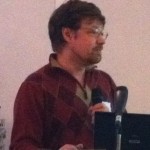 Andrei Borago andrei_burago@hotmail |
Verb Control in Constructed LanguagesVerb control in natural languages is often illogical and difficult to learn. In different languages, verbs with the same or very close meanings may have completely different control. Often, changing the way a verb controls its objects changes its meaning. While some conlang authors are happy to leave the topic of verb control out of scope, many try to address it in one way or another. This becomes a particularly acute topic for auxlangs as speakers with different backgrounds tend to use different verb control and assign different semantic meanings to differently controlled objects. During the talk, we first walk through a number of examples of how verb control is organized in natural languages. We will briefly look at morphosyntactic alignment, various case systems and the use of prepositions. Various examples will be given, showing how control of the same verbs can be dramatically different in different languages. Next, we will look at a number of attempts to address the issue of verb control in existing conlangs. We will discuss the most common approaches, and look at examples, starting with classics like Esperanto and then moving to more modern works like Loglan. |
 Mechthild Czapp rejistania@nullme.com |
Technology Vocabulary in RejistanianIf someone from a different time would see the modern world, s/he would be quite confused. Our mice don’t squeak, our keyboards don’t play music or hold keys, except of course for the ones which do not open doors. And don’t get me started on joysticks… When new concepts arrive in the world they do not arrive with new words already attached, instead, words are repurposed, re-repurposed and re-re-repurposed for the new concepts. This presentation aims to show how the process happened in Rejistanian but you are encouraged to use its structures in your own languages and projects. |
| Mechthild Czapp got into conlanging through philosophy class where language and fundamentals were discussed and related websearches led her to Rosenfelder’s Languge Construction Kit. Rejistanian was her first conlang, which has been under development since 2001. When she discovered the game NationStates in 2003, she used the game to give the constructed nation of Rejistania a virtual home. She immigrated into Ireland and works in technical support. | |
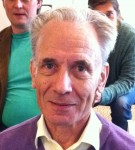 Johan Derks derks.esp@nulltiscali.nl |
The Importance of “International” Words to Auxiliary Languages and How to Define ThemMany international auxiliary languages (IALs) are judged based on the familiarity of their vocabulary to speakers of various languages around the world. But which words are suitable to be borrowed in – and from which languages? In this talk, Johan discusses criteria for incorporating loan words into IALs that have been used throughout history, and also proposes criteria of his own. |
| Johan Derks was born in 1940 to Dutch middle-class parents in Utrecht, the Netherlands. He learned Esperanto at the age of fifteen in secondary school. Johan studied theoretical physics (1957-1965) and sociology (1973-1979), and taught mathematics in Uganda and statistics in Cameroon, for a total of four years. Following his return to the Netherlands, he taught mathematics at various levels. He has been active in various fields such as the peace movement in the sixties and Amnesty International. Since 2005 he is a husband in an Esperanto-based marriage to a Serbian Esperantist, Svetlana Milanović. | |
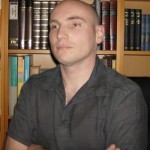 Christophe Grandsire-Koevoets tsela.cg@nullgmail.com |
When Morphology Kicks Syntax Out of the Way, When English Just Seems to Lack the Words, When a Boy Plays with the One That Is Wearing the Beret, and When Over-Long and Obscure Titles Seem Like the Way to Go: an Introduction to SurdéclinaisonEngelangers are not the only ones who are fascinated by the limits of human language. Even the most naturalistic artlangers, consciously or not, explore the human language space and seek its borders, even if they do it from the inside. The search for language universals is an enthralling one. One universal that is hardly ever questioned is a fact of language structure: that inflectional morphology is finite (i.e. however complicated a declension or conjugation system may be, the total number of inflected forms a word can take is always finite) and that only syntax allows us to form an infinite number of utterances. In particular, most linguists consider recursion to be strictly restricted to syntax. But is that true? After illustrating this universal using examples from various natlangs and conlangs, this talk will start poking holes in it. First, we will take a look at Suffixaufnahme, a type of agreement phenomenon where inflected noun phrases completing other nouns receive a copy of the inflections of their heads, and how this phenomenon results in recursion at the inflectional level. But even Suffixaufnahme is limited in its application, so we will move to the phenomenon of surdéclinaison, a term used by French linguists to refer to the ability in some languages to add inflections to already inflected forms. After a short passage via Armenian, we will focus on the Basque language, basically the poster language for surdéclinaison. We will show the various types of surdéclinaison found in Basque, and will show how it makes paradigm tables virtually infinite. Finally, in order to illustrate how surdéclinaison can be used in conlanging, the presenter will show examples of his conlang Moten, a language he created specifically to play with surdéclinaison phenomena. |
| Christophe Grandsire-Koevoets has always been fascinated by language, and especially language structure and grammar. He started conlanging at the age of 13, during a Latin class that was boring him to death. His first attempts were rather forgettable, but as he learned more languages (and more about language itself), he started to get really into the art of language creation. He joined the Conlang Mailing List in 1998, and has been a regular participant since then, known for his eclectic knowledge of linguistics (despite an absence of formal training), his rather unusual, and opinionated, views on French grammar, and his strong opinions on the very idea of language universals. When he is not organising the Language Creation Conference or conlanging, Christophe works as an engineer in a big national and international company, reads Terry Pratchett books, watches Japanese animation and live action series, plays on his Wii console, writes web fiction and walks his dog. He has also been trying to create the 48-hour day, without success so far. He is a 35-year-old Frenchman who has been living for the past ten years in the Netherlands, and has been married with his husband Jan for more than four years. | |
 Sven Huynink sven.huynink@nullxs4all.nl |
The Case for Verb Classes and Quirky SubjectsMy first full-fledged conlang, Æleńa, is built upon three basic requirements: it is/should be a genuine Celtic/Indo-European language, it has to be beautiful (‘cellar door’ ;-), and it should show some semantic consistency. Conforming to the latter two inclinations tends to have Æleńa drift away from the first requirement – voilà the challenge of this conlang. In my talk I will focus on one important semantic battle ground: verb classes and how to consistently represent them. I will describe how it came to be an interest, how I searched and (for the purposes of my tongue) discarded the various systems and approaches of Beth Levin, Fillmore, Vendler, Kenny and even good old Aristotle. But also how I made use of (some of) the insights of Rick Morneau, Dixon, Butt, Tsunoda and Malchukov and even of our own President (no, not Obama, the other one) to construct a three-conjugation five-types-of-quirky-subject solution. Don’t worry, I won’t bury you under a linguistic who-is-who pile, just sketch a personal quest for semantic clarity (which to others may be a logical twilight) and in the end even show a glimpse of a way to reconcile this solution with the language’s Celtic/Indo-European roots. |
| Sven Huynink has toyed with concouns (constructed countries) since he was 10, and also dabbled with languages within the framework of his countries, but apart from studying Tolkien languages in his teens and following an Esperanto class in his twenties, he only started his first serious conlang effort eight years ago. Æleńa, a t-Celtic language (as opposed to q-Celtic Irish and p-Celtic Welsh and Breton) is spoken in Ælenor, an island confederation off the coast of France and Spain. Well… spoken…: progress is slow, as he loves to have second thoughts about all chosen solutions, and is ever on the lookout for more ‘cellar door’ alternatives. And as he avidly reads any pdf available on the Net on the current linguistic topic, alternatives abound. But though he has spent hundreds of pleasant evenings, many a night and countless free moments with Æleńa, he nevertheless just regards it as a preliminary exercise; once he will get of age (if ever he will) all he has learnt will be applied to the isolated language family of Alm Aín, the eight continent, in the Pacific. | |
| Chrysaor Jordan ndongo@nullxs4all.nl |
Ŧéng Ŧuàn: A Preliminary MonographChrysaor will describe briefly Ŧuàn State, in the context of a fictional world which includes (inter alia) dinosaurs. He will then briefly compare/contrast the Ŧuàn with China and South Africa. He will then discuss the three prominent features of his language: isolating syntax resembling Chinese, contextual dependencies, and how the language is organised around what he calls triplets. |
| Chrysaor Jordan was born in the United States, and now lives in the Netherlands. His interest in Conlangs occurred because he was given literary advice – use only English, do not burden the reader with another language – that he did not agree with. Years later, after becoming bilingual in Dutch, he began working out the details of Ndongo in general, and the Ŧuàn language in particular. At present time, Ŧuàn is still a work in progress, but he has other languages planned: Tsoi, anari, and Đasukuya.
His literary inspirations include Chinua Achebe and Jorge Luis Borges. His musical inspirations include Brian Eno and world music. When not working on a conlang, Chrys Jordan is busy with (1) his wife, Hilde; (2) drawing amateur sketches of footballers, or (3) at work delivering the post in Bilthoven. |
|
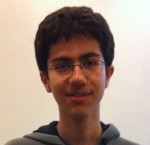 Mert Köseoğlu mert1295@nullhotmail.com |
On Olesi |
| Mert Köseoğlu is a fifteen year old student from Turkey. He’s studied a number of natural languages, and recently begun work on his first conlang, Olesi. He’s been working on the language steadily for over a year. | |
 Philip Newton philip.newton@nullpobox.com |
Screening of Der Liebe LeoFor a short film from the perspective of a dog, Brenda Hilbig wanted the humans to speak an incomprehensible but natural-sounding language. Through the Language Creation Society, she commissioned Olivier Simon to produce a phonology sketch and translate dialogue into that language sketch. This film will be shown here – with the dog’s thoughts voiced-over in English and the humans speaking the constructed language. |
| Philip Newton has been reading dictionaries for fun since he was a little child, and devised a personal phonemic transcription scheme for French before he had ever heard of the word “phoneme”. Fascinated by languages, he always finds it hard to answer the question, “So, how many languages do you speak?”. This fascination extends to conlangs, too; he has looked at – to a greater or lesser extent – many languages created by others, including Esperanto, Verdurian, Lojban, Klingon, Toki Pona, Slovianski, and gjâ-zym-byn. His own limited forays into active conlanging are mostly a-posteriori languages based on Greek (graeclangs? hellenoglots?). Disclaimer: Philip’s involvement with the constructed language of the film was limited to establishing the contact between Brenda and the LCS; it’s no personal achievement of his. (However, the English you hear is based on a translation he made for Brenda of the German dialogue.) | |
 Njenfalgar njenfalgar@nullgmail.com |
How to Invent Five Conlangs in Forty-Five Minutes (and Still Leave Ample Time for Discussion)Njenfalgar will describe some techniques that can be used to construct naming languages or sketchlangs, aimed at giving background to some fantasy novel (inventing names for characters and translating the eventual exhortation, wise saying or line of poetry) or at having a language from which the naturalistic conlanger’s main conlang can borrow words. This will mainly be done by using bits and pieces of natlangs (phonology, phonotactics, recent sound-changes, word-building, grammar…) and putting these together to make a new language. |
| Njenfalgar started conlanging at the age of seven. His first conlanging efforts not being very much appreciated by his parents, they ended in the rubbish bin thrice before he gave up on it. However, conworlding and story-telling have never ceased taking up most of his free time, and conlanging has invariantly followed from it. He is now mostly working on Troilgulm (.pdf) and its daughter languages Treoygeum, Trayem and as-yet unnamed others. The occasional side-track has led him to invent Sënjwuk, shain-N|órt, the intergalactic auxlang, yoi-karocopa Ngamoqíha and many others.
In his not-free time he has studied physics, so as to be sure the wormhole technology in his conworlds is consistent. But then he got diverted away from general relativity and astrophysics to quantum gauge theories, which are quite useless for conworlding, although they can be interesting in their own right. |
|
 David J. Peterson dedalvs@nullgmail.com |
Case Assignment and Verb Classes in DothrakiIn natural languages, noun cases tend to have a prototypical usage, and then extended uses dependent upon the prototypical usage for that case, and the demands of the linguistic system in which it’s used. Dothraki is no different, using its relatively small case system to meet the demands of a verbal system that requires more specificity. In this talk, David will discuss some of the verb classes of Dothraki, and how they interact with Dothraki’s case system. |
| David J. Peterson received a BA in English and a BA in Linguistics from UC Berkeley, where he discovered language creation via a class on Esperanto. Since then, he’s made it a goal of his to learn more about language and linguistics (MA UC San Diego) in order to create more naturalistic languages. He’s the author of ten or so languages (among them Zhyler and Kamakawi), and is now a consulting editor of and contributor to Speculative Grammarian. David most recently created the Dothraki language for HBO’s Game of Thrones, an adaptation of George R. R. Martin’s A Song of Ice and Fire series. | |
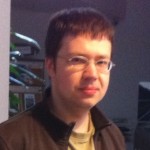 Roman Rausch aranwe@nullmail.ru |
States and Scales in TalmitEnglish, as many other languages, has a grammaticalized plural of count nouns, like “apples” from “apple”. Sometimes, it allows a lexical collective plural, like “herd” or “flock”. When it comes to mass nouns or abstract conceptions, one can use words like “very” or “much” for intensification. Rarely, intensification is lexical, as in “hot” compared to “warm”. Talmit goes one step back and treats concepts like “weak” and “strong” or “warm” and “cold” as various degrees of quantification of the same root, and expresses them by affixes. The two main ideas behind its design are therefore: 1) having states as separate part of speech, distinct from verbs, and 2) the association of scales with them, on which the whole quantification business can be performed. |
| Roman Rausch discovered Tolkien’s languages by the age of 17 and started to study them, first passively, and then actively—by writing articles and analyses and publishing them on the Internet. Recently, he has taken over responsibility over the main German site and discussion forum dedicated to Tolkien’s languages, www.sindarin.de. Two years ago, he was finally swayed into trying conlanging out for himself and began fleshing out the Tallic language family, beginning with Talmit. His aim is to provide each language with a unique yet not unnaturalistic feature, while maintaining their relatedness. | |
 Lykara Ryder l.ryder@nullsheffield.ac.uk |
Author-Created Languages: Complicating the Reading while Keeping the ReaderPeople don’t read books in languages they don’t know…except for when they do. What should be a self-evident statement is confounded by the linguistic inventions that authors have been using for centuries: their very own, entirely created languages. Choosing to alter the mode of communication, the language itself, in a written work is not a trivial decision. Readers have to ‘work harder’ for meaning when sections of a text are rendered in a language known only to the author, yet people will cheerfully buy, read, and recommend novels with author-created languages. Though most authors do not bother investing much more than an interesting phonemic inventory in their languages, examples cover everything from pre-linguistic grunts to acquirable languages. In some instances, they represent a huge project that has been undertaken separately from the creative work of writing a book. Including fictional languages in literature is hardly obligatory. In such cases, something inescapably important is being done to the reading experience – it is being deliberately complicated. How do authors overcome that, if they even want to? How do readers react? What methods are used to present these languages to non-native speakers, namely, the reading audience? It is important to look at author-created languages as a purposeful subset of the larger category of non-natural language precisely because they are presented in texts. By looking at the linguistic and stylistic features used in the representation of fictional languages in texts across several centuries, my research aims to explore the relationship between creative writing, philological enquiry, and linguistics in both its academic and non-specialists forms. For this case study, I will focus on some late sixteenth- to early seventeenth-century novels’ representations of fabricated linguistic material to give greater depth to our modern understanding of the practice of conlanging in speculative fiction. |
| Lykara Ryder is, to her great shame, not a conlanger. She is instead a reader, a lover of languages, and one of those people who can’t seem to stop going to school. She earned a BA in English Literature and a BA in Linguistics at the University of Maryland, College Park. Her MA from the University of Sheffield was on artificial languages in classic novels and led in nicely to her current postgraduate research degree, which examines the historical progression of author-created languages. Everyone who knows her well agrees that this was, frankly, inevitable. Lykara is most likely to be found nose-deep in a book (which pleases her), avoiding foods with gluten (which annoys her), or laughing with her husband (which makes her feel complete). | |
 Jan van Steenbergen ijzeren.jan@nullgmail.com |
Towards a Unified Slavic Language: Past, Present and Future of the Interslavic Language(s)The Slavic language family consists of some fifteen languages, most of which have evolved beyond mutual understandability. Over the centuries, many people have been pondering about a Slavic language that would be understandable to all Slavs. According to some scholars, Old Church Slavonic was actually a constructed language, created over a thousand years ago by St. Cyril and St. Method. Even if we disregard Old Church Slavonic, the first publications in “Slavic” date back to the 16th century, and since the 17th century, over sixty different projects have been launched, carrying names like “Panslavic”, “Interslavic”, “Common Slavic” or simply “Slavic”, which describe a language for Interslavic communication. Even though nowadays Pan-Slavism is practically dead as a political ideology, their number has more than doubled since the birth of the Internet. Can these projects be considered separate languages, or should they rather be treated as various efforts at the very same language? What are the differences between them, and what different approaches do they represent? Can these differences be overbridged, and how? And what are the perspectives for an Interslavic language nowadays? |
| Jan van Steenbergen (3 June 1970) studied East European Studies at the University of Amsterdam and has been a professional Polish translator and interpreter since 1997. His fascination with foreign languages dates back to his early childhood, and in the 1980s he made his first conlang sketches. He is the author of several conlangs, including Hattic (1996), Wenedyk (2002) and Vozgian (1996, revised in 2003), as well as orthography projects like Poilschi (2005) and Polish Cyrillic (2008). All these projects revolve somehow around the Polish language or the Slavic languages as a whole. In 2006, he got involved in the Slovianski Project and become the author of a naturalistic version of the language, Slovianski-N, which is now known as Slovianski. Apart from languages, his main interests are history, writing, music composition and Indian cinema. Furthermore, Jan has been a member of Ill Bethisad since 2002, where he is responsible for the Republic of the Two Crowns and Russia. He is married and has three children. | |
  Jan Strasser and Tam Blaxter cedh_audmanh@nullyahoo.de |
Akana: A Long-Lived Collaborative ConworldCollaborative conworlding projects are rarely successful. When they are proposed on a web forum or mailing list, they often receive enthusiastic responses at first, but then fade out of favour after only a few months of activity. The Akana project, however, has been running for six years so far. It features one of the largest known conlang families, and new material is still being created by a stable team of about a dozen main contributors. What is the key to its longevity? The talk will summarize the rather unique history of this conworld, which has developed from two diachronic conlanging games, and outline strategies that have helped to keep it alive for such a long time. We will have a detailed look at how some significant pieces of content were assembled, describe how these particular methods of collaboration have shaped the world of Akana, and single out obstacles that have arisen as the result of a certain approach. Some of the conclusions drawn from our experience with Akana may be applicable to other collaborative projects as well, and we hope to provide some hints how to keep people interested in contributing. |
| Jan Strasser (born 1979), also known as cedh audmanh [kʰɛð˳ ɑo̯dmɑːn], encountered the conlanging community in 2006 while doing research on linguistics-related projects for his graduation thesis in culture and media studies, and he has been active as one of the main contributors to the Akana project ever since. His conlangs include Buruya Nzaysa, Ndok Aisô, Cǝssın, Tmaśareʔ, and Doayâu, most of which have already featured in at least one Conlang-L translation relay. Jan’s main interest in linguistics is synchronic variation and diachronic change, especially in syntax and morphology. He lives in Berlin.
Tam Blaxter discovered conlanging through studying Tolkien at the age of 12. It sparked an interest in languages and linguistics which later led him to study linguistics at the undergraduate level – he has every intention of continuing these studies, and will begin a masters in philology in the autumn. He has been an intermittent poster on the ZBB (under the pseudonym TzirTzi) since 2005 and his conlangs available online include Proto-Núalís-Takuña, Takuña, Aríe, Yēt, Wistervitezj, and Proto-Coastal-Western. His main areas of interest are diachronic variation and phonology. |
|
| Henrik Theiling |
On a Language with AdverbialsEngineered languages, or engelangs for short, are often language experiments where the creator tries to explore natural language by driving some aspect, often grammar or phonology, to its extremes. It may be that the regularity or the irregularity is extreme. There are languages with nothing but verbs, or with all possible grammatical categories represented explicitly in grammar. This talk will report about an experiment of constructing a language where adverbials are the basic skeleton everything is based on. The design goal is to construct a viable language from adverbials plus a minimal set of grammar rules. |
